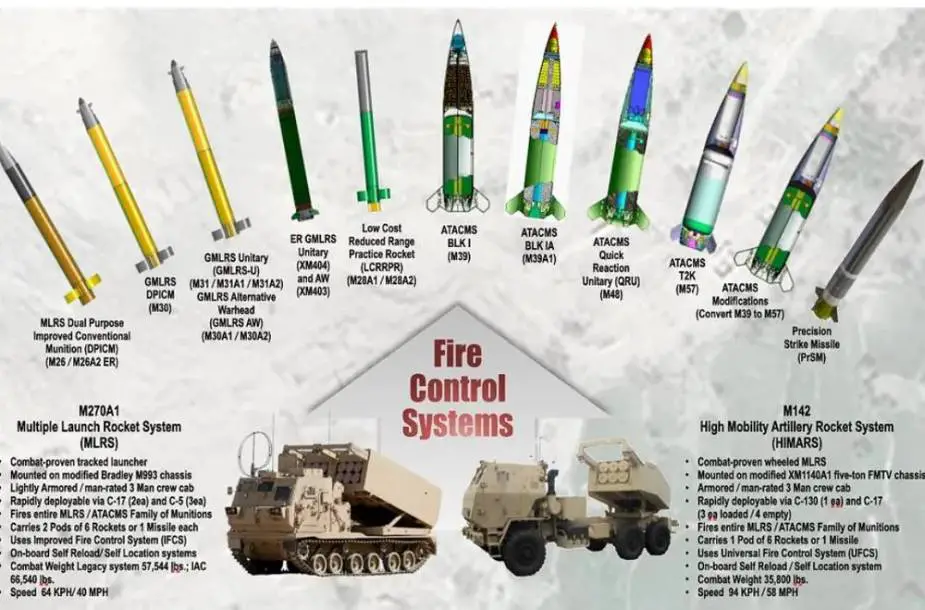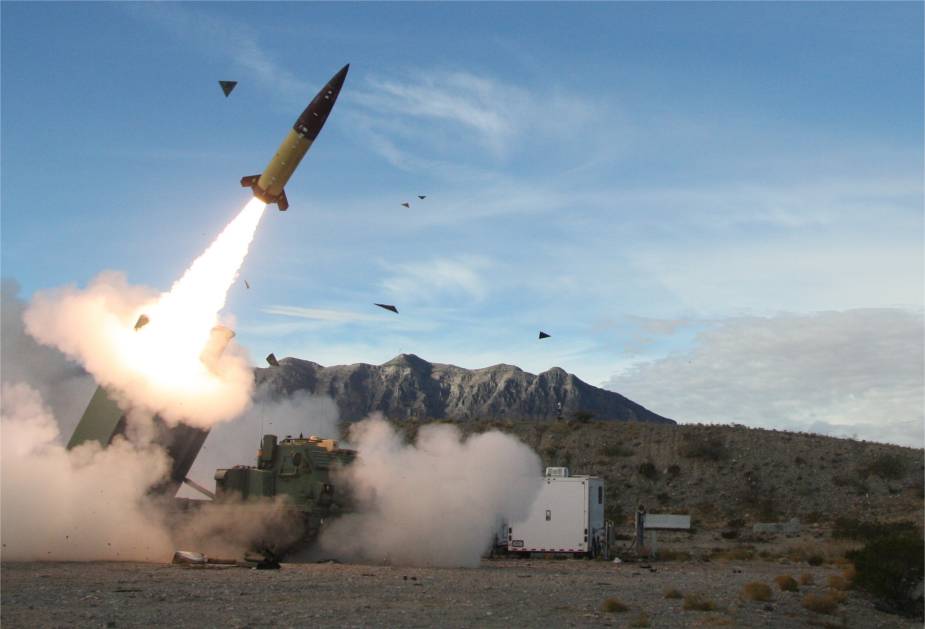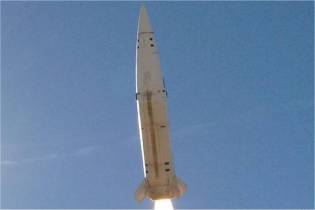ATACMS MGM-140 Army Tactical Missile System
Short-range tactical ballistic missile - United States

Description
The Army Tactical Missile System (MGM-140 ATACMS) is a short-range tactical ballistic missile system developed by the United States Army. Its primary purpose is to provide a precision-strike capability for ground forces, enabling them to engage high-value targets at long ranges with precision and minimal collateral damage. The development of the ATACMS began in the late 1970s as a response to the growing need for a highly mobile and accurate tactical ballistic missile system to support the United States Army's field operations. The goal was to provide a long-range, precision-strike capability to engage high-value targets, such as enemy command and control centers, air defense systems, and other strategic assets. The U.S. Army awarded a contract to Martin Marietta (now part of Lockheed Martin) in 1986 to develop the ATACMS. The missile's development focused on accuracy, mobility, and minimizing collateral damage. The design incorporated a solid rocket motor and GPS/INS (Global Positioning System/Inertial Navigation System) guidance, which allowed for highly accurate targeting and a reduced chance of causing unintended damage to civilian infrastructure. The first flight test of the ATACMS was conducted in 1988, and the missile successfully hit its target. Over the next few years, the system underwent rigorous testing to refine its capabilities and ensure its readiness for deployment. The Army Tactical Missile System (ATACMS) can be launched from two primary mobile platforms including the M270 tracked MLRS (Multiple Launch Rocket System) and the M142 HIMARS (High Mobility Artillery Rocket System).
The ATACMS officially entered service with the United States Army in 1991, just in time for the Gulf War. During Operation Desert Storm, the system proved its worth, successfully engaging and neutralizing several high-value targets, which contributed to the rapid defeat of the Iraqi forces. Since then, the ATACMS has seen numerous upgrades and has been deployed in various conflicts, such as the Iraq War and ongoing operations in the Middle East. The system remains an essential component of the U.S. Army's long-range strike capabilities and is expected to continue serving as a key asset for the foreseeable future. (Thanks to Chuck Pfarrer for the graphic in the details section)
On November 29, 2023, the United States officially confirmed the delivery to Ukraine of ATACMS (Army Tactical Missile System) giving Ukrainian Forces to strike deep-area targets in their country to deny Russia’s forces a safe haven. According to information published by NBC News on February 19, 2024, discussions within the United States have emerged regarding the potential provision of a new long-range variant of the Army Tactical Missile System (ATACMS) to Ukraine.
ATACMS MGM140 Army Tactical Missile System variants:
Over the years, several variants of the ATACMS have been developed to meet the evolving needs of the U.S. Army. The most notable variants include the MGM-140A Block I, MGM-140B Block IA, MGM-164A Block II, and MGM-168 Block IVA. These variants offer an increased range, improved accuracy, and different payloads, such as unitary warheads or sub-munitions, to address various mission requirements.
Technical Data
| Design |
|
The ATACMS MGM-140 has a cylindrical body with a slender profile that tapers towards a conical nose cone. This shape improves the missile's aerodynamic properties, reducing drag and allowing for stable flight. The streamlined nose cone minimizes air resistance and houses the missile's guidance system and warhead. The shape of the nose cone is essential for maintaining missile stability and ensuring accurate flight towards the target. The ATACMS has four tail fins located at the rear of the missile. These fins provide aerodynamic stability and control during flight, ensuring that the missile remains on its intended trajectory.
|
 |
| Propulsion |
|
The Army Tactical Missile System (MGM-140 ATACMS) utilizes a solid rocket motor for propulsion which offers a number of advantages over liquid-fueled rocket systems. These benefits make the solid rocket motor an ideal choice for a tactical ballistic missile such as the ATACMS. The advantages include increased reliability due to having fewer moving parts and a lower likelihood of leaks and failures. Additionally, solid rocket motors provide a quicker response time because they can be ignited rapidly, which is crucial for time-sensitive missions like engaging high-value targets in fast-changing battlefield scenarios. Furthermore, solid rocket motors demand less maintenance compared to their liquid-fueled counterparts, making them more suitable for field deployment and reducing the necessity for extensive support infrastructure. Lastly, solid propellants are generally less hazardous than liquid propellants, which minimizes the risk of accidents during handling, transport, and storage. Using a solid rocket motor in the ATACMS contributes to its success as an accurate, reliable, and effective tactical ballistic missile system.
|
| Warheads |
| The Army Tactical Missile System (MGM-140 ATACMS) can be equipped with different types of warheads depending on the specific variant and mission requirements. The primary warhead types include unitary warheads and cluster munitions. The unitary warhead is designed for precise strikes against high-value, hardened targets such as enemy command and control centers, air defense systems, and infrastructure. This type of warhead carries a single, high-explosive charge that detonates upon impact, causing significant damage to the target. Some ATACMS variants, such as the MGM-140B Block IA and the MGM-168 Block IVA, use unitary warheads to provide enhanced accuracy and reduced collateral damage compared to cluster munitions. Cluster munition warheads contain multiple smaller submunitions or bomblets that are dispersed over a target area upon reaching the designated altitude. This type of warhead is suitable for attacking area targets, such as enemy troop concentrations, airfields, and supply depots, or engaging multiple targets within a target area. The MGM-140A Block I is an example of an ATACMS variant that uses cluster munitions. However, it's essential to note that cluster munitions have been criticized for their potential to cause unintended harm to civilian populations and unexploded ordnance, leading some countries to sign the Convention on Cluster Munitions to ban their use. |
 |
| Guidance Systems |
| The Army Tactical Missile System (MGM-140 ATACMS) employs a sophisticated guidance system that combines GPS (Global Positioning System) and INS (Inertial Navigation System) technologies to ensure accurate navigation and targeting. This combination of GPS and INS enables the ATACMS to accurately strike its intended target with minimal collateral damage. The Global Positioning System is a satellite-based navigation system that provides highly accurate location data. In the ATACMS, the GPS receiver calculates the missile's position using signals received from multiple GPS satellites. This positional information is used to guide the missile towards its target throughout its flight. The Inertial Navigation System is a self-contained navigation system that uses accelerometers and gyroscopes to measure the missile's motion and orientation. INS does not rely on external signals or information, making it immune to jamming or interference. The INS continuously calculates the missile's position, velocity, and attitude, providing accurate and real-time guidance data throughout the flight. In conclusion, the integration of GPS (Global Positioning System) and INS (Inertial Navigation System) in the ATACMS guidance system offers key advantages that significantly enhance the missile's performance and effectiveness. The combination of GPS and INS ensures highly accurate targeting, which is crucial for minimizing collateral damage and successfully engaging high-value targets in various mission scenarios. The inclusion of INS also makes the guidance system resistant to electronic jamming and interference, allowing the ATACMS to navigate and maintain its accuracy even in contested environments where adversaries may attempt to disrupt GPS signals. Furthermore, the INS component enables the ATACMS to navigate independently without relying on external signals or information, reducing its susceptibility to enemy countermeasures and improving its overall reliability. These advantages contribute to the ATACMS's status as a highly effective tactical ballistic missile system capable of delivering precision strikes at long ranges while minimizing the risk of unintended harm to civilians and infrastructure. |
| Combat Use |
| The MGM-140 ATACMS is used to strike high-value targets such as enemy command and control centers, air defense systems and infrastructure and provide fire support for ground forces. The ATACMS has a top speed of approximately Mach 3, or around 3,700 km/h (2,300 miles per hour). The range of the ATACMS varies depending on the specific variant. The earlier MGM-140A Block I has a range of approximately 160 km (100 miles), while the later MGM-164A Block II has an extended range of up to 300 km (186 miles). During the flight, the ATACMS typically reaches an altitude of approximately 50 to 65 km (30 to 40 miles). This altitude allows the missile to avoid most surface-to-air defense systems while still maintaining the accuracy needed for precision strikes. The combination of GPS and INS results in a highly accurate targeting system. While the exact Circular Error Probable (CEP) for the ATACMS is classified, open sources suggest that the CEP for ATACMS Block IA, equipped with a unitary warhead, is around 10 meters or less. The Army Tactical Missile System (ATACMS) can be launched from two primary mobile platforms including the M270 tracked MLRS (Multiple Launch Rocket System) and the M142 HIMARS (High Mobility Artillery Rocket System) rocket/missile launcher vehicle mounted on an FMTV wheeled truck chassis. The M270 MLRS is a tracked vehicle that serves as a highly mobile and versatile launcher platform for the ATACMS, as well as other rockets and missiles. The M270 can carry and launch up to two ATACMS missiles at a time. Its tracked design allows it to traverse various terrains, making it suitable for deployment in diverse environments. The M142 HIMARS is a wheeled launcher platform designed for even greater mobility and faster deployment compared to the M270 MLRS. The HIMARS can carry and launch a single ATACMS missile. Its wheeled design and lighter weight enable it to be easily transported by C-130 and larger transport aircraft, allowing for rapid deployment to distant theaters of operation. |
 |
| The ATACMS can be launched by the M270 or M142 HIMARS MLRS Multiple Launch Rocket Systems |
Specifications
| Type | Accuracy |
| Short-range tactical ballistic missile | Around 10 meters or less |
| Country users | Launch Weight |
| United States | 1,600 to 2,300 kg depending on the specific variant of the missile. |
| Designer Country | Speed |
| United States | Approximately Mach 3, or around 3,700 km/h |
| Guidance Systems | Range |
| GPS/INS | 160 to 300 km |
| Launcher Vehicles | Dimensions |
| M270 and M142 HIMARS MLRS | Length: 5,75 m; Width: 2,49 m; Height: 2.4 m |
Details View
 |
|
 |
 |
Pictures - Video















